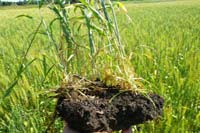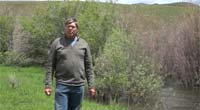Browse our Growing Library of Success Stories
By:
Working Lands for Wildlife Prescribed burns and strategic grazing practices have made the Nichols Ranch more profitable, as well as more productive for livestock and wildlife.
Prescribed burns and strategic grazing practices have made the Nichols Ranch more profitable, as well as more productive for livestock and wildlife.
By:
Working Lands for Wildlife
Landowners Tim and Sarah Bailey work with a conservation-minded ranch manager to keep South Dakota’s prairies intact and profitable for livestock grazing.
By:
Working Lands for Wildlife
Chris and Cole Mushrush are keeping grasslands tree-free on their ranch in Strong City, Kansas, and using virtual fencing to repair eroding soils.
By:
Working Lands for Wildlife This ranch in the Sandhills relies on healthy prairies to support two businesses: a tourist-based outfitting company and for feeding cattle.
This ranch in the Sandhills relies on healthy prairies to support two businesses: a tourist-based outfitting company and for feeding cattle.
By:
Working Lands for Wildlife GREAT PLAINS ‘GUARDIANS OF THE GRASSLANDS SERIES | Scott Westrup was one of the first landowners in Oklahoma to sign up for the NRCS Great Plains Grassland Initiative to get rid of trees infesting his pastures.
GREAT PLAINS ‘GUARDIANS OF THE GRASSLANDS SERIES | Scott Westrup was one of the first landowners in Oklahoma to sign up for the NRCS Great Plains Grassland Initiative to get rid of trees infesting his pastures.
By:
Working Lands for Wildlife “Little Miss Clearcut” is restoring the prairie with loppers and a handsaw to keep woody invaders from taking over her grassland pastures.
“Little Miss Clearcut” is restoring the prairie with loppers and a handsaw to keep woody invaders from taking over her grassland pastures.
By:
Ted WilliamsFish are cold, slimy, unfeathered, unfurred, unheard, and usually unseen by non-anglers. So for the general public, including much of the environmental community, fish don’t count as wildlife.
By:
Family Farm AllianceThis multi-generation family takes care of their livestock and ranch in a way that prioritizes the health of the land. They actively participate in conservation efforts and land stewardship programs, including conservation easements and river bank restoration projects in partnership with Fish and Wildlife. Preserving the integrity of their ranch and managing it responsibly is of utmost importance to them, and they have put considerable effort into estate planning to ensure its continued success.
By:
Jeff DiLuccia Nikos Monoyios has transformed the Lemhi river in northeastern Idaho to restore salmon spawning habitat. Nikos owns Eagle Valley ranch just south of salmon, Idaho. What Nikos and his wife Valerie have done is truly Olympian, and just proves Margaret Meade’s famous saying that :”Never doubt that a small group of thoughtful, committed citizens can change the world…” Nikos is the living embodiment of private land owners being the phalanx for conservation and species restoration.
Nikos Monoyios has transformed the Lemhi river in northeastern Idaho to restore salmon spawning habitat. Nikos owns Eagle Valley ranch just south of salmon, Idaho. What Nikos and his wife Valerie have done is truly Olympian, and just proves Margaret Meade’s famous saying that :”Never doubt that a small group of thoughtful, committed citizens can change the world…” Nikos is the living embodiment of private land owners being the phalanx for conservation and species restoration.
By:
Sage Grouse Initiative Research from an eight-year study in the Warner Mountains shows why strategically removing encroaching trees spells good news for sage grouse, a declining upland bird that serves as a benchmark for the overall health of the sagebrush biome. Researchers quantified a six-fold increase in sage grouse’s preferred habitat following woodland management and a population growth rate that was +12 percent higher in the treated area than in the control area without management.
Research from an eight-year study in the Warner Mountains shows why strategically removing encroaching trees spells good news for sage grouse, a declining upland bird that serves as a benchmark for the overall health of the sagebrush biome. Researchers quantified a six-fold increase in sage grouse’s preferred habitat following woodland management and a population growth rate that was +12 percent higher in the treated area than in the control area without management.
This adds to a growing list of research — much of it based on the long-term study in the Warners — that documents the myriad benefits of conifer removal for wildlife and grazing lands.
By:
Leopold Conservation Award Program For Colby and McKenzie Pace, raising beef cattle includes keeping a sharp eye on preventing overgrazing and noxious weeds and seeking out ways to improve their land for nesting and migrating shorebirds. This forward-thinking approach to livestock and wildlife management earned the Coalville couple — and their Half Circle Cross Ranch — the 2020 Utah Leopold Conservation Award.
For Colby and McKenzie Pace, raising beef cattle includes keeping a sharp eye on preventing overgrazing and noxious weeds and seeking out ways to improve their land for nesting and migrating shorebirds. This forward-thinking approach to livestock and wildlife management earned the Coalville couple — and their Half Circle Cross Ranch — the 2020 Utah Leopold Conservation Award.
By:
K. Gregg Elliott The nonprofit Soil Health Academy (SHA) is just one of many initiatives spawned by regenerative agriculture guru Gabe Brown in collaboration with additional expert partners. SHA holds regenerative agriculture workshops around the country that are open to anyone who’s interested, and they are routinely sold out.
The nonprofit Soil Health Academy (SHA) is just one of many initiatives spawned by regenerative agriculture guru Gabe Brown in collaboration with additional expert partners. SHA holds regenerative agriculture workshops around the country that are open to anyone who’s interested, and they are routinely sold out.
By:
Steve Stuebner Landowners and conservation professionals are excited about a new type of woody structure that mimics beaver dams. The benefits are similar – they store water, slow down runoff in streams, and enhance fish and wildlife habitat. They’re called Beaver Dam Analogs or BDA’s for short.
Landowners and conservation professionals are excited about a new type of woody structure that mimics beaver dams. The benefits are similar – they store water, slow down runoff in streams, and enhance fish and wildlife habitat. They’re called Beaver Dam Analogs or BDA’s for short.
By:
Steve Stuebner The Commission’s two-year grant-funded project to restore wet meadows in southern Idaho benefiting sage grouse and wildlife habitat, due to conclude in June 2020, has already exceeded most of its deliverables. Partners and landowners and are pleased.
The Commission’s two-year grant-funded project to restore wet meadows in southern Idaho benefiting sage grouse and wildlife habitat, due to conclude in June 2020, has already exceeded most of its deliverables. Partners and landowners and are pleased.
 Conservation professionals turned a negative into a positive in the aftermath of the 65,000-acre Sharps wildfire on Baugh Creek in the Little Wood watershed in Central Idaho.
Conservation professionals turned a negative into a positive in the aftermath of the 65,000-acre Sharps wildfire on Baugh Creek in the Little Wood watershed in Central Idaho.
By:
Gregg Elliott When Heather Dutton, fresh out of undergraduate school at the Warner College of Natural Resources and graduate school in the College of Agriculture at Colorado State University, began her first job working for a non-profit river restoration organization in the San Luis Valley, she was thrilled. She also felt confident that her technical training in restoration ecology had prepared her for the challenges she’d soon be facing.
When Heather Dutton, fresh out of undergraduate school at the Warner College of Natural Resources and graduate school in the College of Agriculture at Colorado State University, began her first job working for a non-profit river restoration organization in the San Luis Valley, she was thrilled. She also felt confident that her technical training in restoration ecology had prepared her for the challenges she’d soon be facing.
Heather was in for a surprise.
By:
Steve Stuebner Ten years in the making, the objective of the project was to keep “working forests working,” while knitting together checkboard-ownership of private lands with state endowment trust lands to provide open space for moose, elk, deer and bears to travel a between the Cabinet Mountains to the east and the Selkirk Mountains to the west via a narrow valley, known as the “Purcell Trench,” surrounding the McArthur Lake WMA.
Ten years in the making, the objective of the project was to keep “working forests working,” while knitting together checkboard-ownership of private lands with state endowment trust lands to provide open space for moose, elk, deer and bears to travel a between the Cabinet Mountains to the east and the Selkirk Mountains to the west via a narrow valley, known as the “Purcell Trench,” surrounding the McArthur Lake WMA.
By:
Natural Resources Conservation Service This video is the story of a young scientist, Hugh Hammond Bennett, who recognized 80 years ago that the United States was at risk of losing it’s most important resource – its soil. He made it his mission to change the trajectory of agriculture at a time of great crisis and to provide farmers and ranchers with the information and tools they needed to be sustainable.
This video is the story of a young scientist, Hugh Hammond Bennett, who recognized 80 years ago that the United States was at risk of losing it’s most important resource – its soil. He made it his mission to change the trajectory of agriculture at a time of great crisis and to provide farmers and ranchers with the information and tools they needed to be sustainable.
This 21 minute video is the story of the conservation movement that Hugh Hammond Bennett began and includes interesting insights into the policies and structures that he set up that we continue to rely on today. His work revealed so much of what we’re rediscovering and renaming as “regenerative agriculture.”
 This is a neat story about dreams coming true. Preston, Idaho rancher Jay Wilde had a dream of restoring beaver to Birch Creek on his cattle ranch near Preston in Southeast Idaho. He tried to restore beaver on his own nickle, but they didn't stay. Jay eventually reached out to Joe Wheaton, a watershed scientist at Utah State University, who helped him solve the puzzle. See how Jay worked with Wheaton and Nick Bouwes from Utah State and Anabranch Solutions to introduce beaver successfully with a science-based plan and low-tech woody structures to create deep-water habitat for beavers.
This is a neat story about dreams coming true. Preston, Idaho rancher Jay Wilde had a dream of restoring beaver to Birch Creek on his cattle ranch near Preston in Southeast Idaho. He tried to restore beaver on his own nickle, but they didn't stay. Jay eventually reached out to Joe Wheaton, a watershed scientist at Utah State University, who helped him solve the puzzle. See how Jay worked with Wheaton and Nick Bouwes from Utah State and Anabranch Solutions to introduce beaver successfully with a science-based plan and low-tech woody structures to create deep-water habitat for beavers.
By:
Steve Stuebner Pine Street Woods opened to great fanfare last autumn. Now the Sandpoint community has a new outdoor space for walking, biking, cross country skiing, connecting with nature and learning about sustainable land management.
Pine Street Woods opened to great fanfare last autumn. Now the Sandpoint community has a new outdoor space for walking, biking, cross country skiing, connecting with nature and learning about sustainable land management.
“We were passionate about this – the idea of having a piece of nature close in, for our entire community to come out and explore, and play, recreate and learn,” said Katie Egland Cox, Executive Director of the Kaniksu Land Trust.